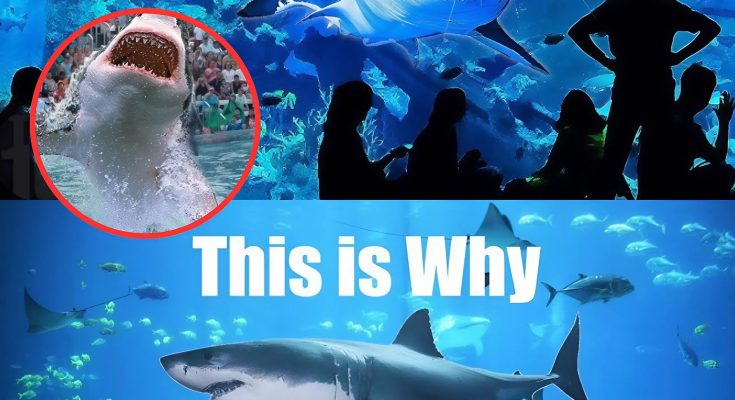For decades, a quiet yet persistent mystery has lingered in the minds of ocean lovers: why, despite our advanced technology, despite aquariums large enough to house whale sharks and manta rays, has no aquarium in the world ever managed to keep a great white shark alive? The absence is striking. The great white is one of the most iconic predators on Earth, celebrated and feared in equal measure, yet behind glass walls, it remains a ghost.
The truth—revealed through decades of failed attempts, scientific research, and ethical debate—is as fascinating as it is heartbreaking. The answer is not simply about size or logistics. It is about biology, psychology, and the limits of human control over nature. What emerges is not only a story about sharks but a deeper reflection of our relationship with the wild.

The Myth and the Mystery
The great white shark (Carcharodon carcharias) holds an unparalleled place in human imagination. From the terrifying cultural legacy of Jaws to nature documentaries that depict its breathtaking power, the animal embodies both fear and awe. For many, the idea of seeing one up close, safely behind glass, is the ultimate dream.
So why hasn’t any aquarium capitalized on that dream? After all, aquariums successfully keep massive whale sharks in tanks that hold millions of gallons of water. They raise delicate coral reef systems, breed sea turtles, and even sustain species rescued from extinction. Surely, with enough money and innovation, a great white could be displayed.
Yet every attempt has failed—and every failure has carried with it a trail of stress, injury, and death.
A Predator Built for Infinity
The first layer of the mystery lies in biology. Great whites are not designed for captivity. They are what scientists call pelagic wanderers. These sharks do not have small home ranges. Instead, they traverse entire oceans, following migratory routes that stretch thousands of miles. Satellite tagging studies have shown individuals traveling from California to Hawaii, and even crossing the Pacific.
In captivity, this instinct to roam becomes a curse. Confinement disorients them. Tanks—even the largest ever built—reduce their movements to repetitive, unnatural circles. Stress builds quickly, and with stress comes a cascade of physiological breakdowns: suppressed appetite, immune system collapse, and erratic behavior.
Unlike many fish that can hover or rest, great whites are obligate ram ventilators—they must keep swimming forward to force oxygen-rich water across their gills. This means the very design of captivity—walls, corners, and artificial boundaries—runs against their survival mechanism.
A Tragic History of Attempts
The scientific record is filled with stories of attempts to hold great whites, each one ending in sorrow.

-
The Early Trials (1950s–1970s): Japanese aquariums experimented with capturing young great whites. Most refused to eat and died within days. In the United States, similar attempts ended with sharks crashing into tank walls in confusion.
-
The Monterey Bay Experiment (2004–2011): The most famous effort came from California’s Monterey Bay Aquarium, which invested millions to build a massive tank and pioneered transport techniques. They managed to keep a juvenile great white alive for an astonishing 198 days. But even this relative success ended with the shark refusing food, showing signs of stress, and finally being released—only for reports later to suggest it did not survive. Subsequent attempts kept sharks for shorter periods, rarely exceeding a few weeks.
Each trial revealed the same heartbreaking cycle: capture, initial hope, followed by disorientation, refusal to feed, injury, and eventual death or release.
The Invisible Burden: Psychological Stress
Beyond biology lies something more elusive: psychology. Great whites are not just physical machines of predation. They are highly attuned, intelligent hunters. Their sensory world is vast—electric field detection, acute vision, smell that can detect blood from miles away. In the wild, these senses are engaged constantly. In captivity, they are dulled or overwhelmed by artificiality.
Imagine an animal evolved to navigate endless horizons suddenly confined to glass walls, fluorescent lighting, and predictable routines. The result is not merely physical decline but psychological collapse. Stress hormones spike, feeding instincts vanish, and survival spirals downward.
Marine biologists now argue that great whites suffer from what can only be described as captivity-induced trauma. Unlike smaller sharks that adapt, or whale sharks that can be conditioned to feed, the great white resists confinement on a mental level as much as a physical one.
Ethical Reckonings
By the early 2010s, many leading aquariums acknowledged what the evidence had long shown: keeping great white sharks in captivity is not only nearly impossible—it is unethical.
The shift reflects a broader transformation in how society views animal captivity. Where once aquariums were celebrated as entertainment venues, they are now scrutinized as centers of education, conservation, and ethics. If displaying a species requires suffering and premature death, does the display justify the cost?
For the great white, the answer is clear. Its absence from aquariums is not a technological gap to be filled but a moral boundary that should not be crossed.

The Symbolism of Absence
And here lies the profound truth: the fact that no aquarium holds a great white is not a failure—it is a powerful symbol.
-
A Symbol of Freedom: The great white, feared and misunderstood, is paradoxically also the ultimate representation of wild freedom. Its refusal to adapt to captivity underscores that some parts of nature cannot be tamed.
-
A Symbol of Respect: By acknowledging this reality, aquariums remind us that conservation does not always mean control. Sometimes, respect means leaving the wild where it belongs.
-
A Symbol of Limits: In an age where humans extend their reach into space and the deepest oceans, the great white humbles us. It reminds us that not everything can be owned, displayed, or mastered.
What the Future Holds
Instead of captivity, the future of human-great white encounters lies in science and technology.
-
Satellite Tagging Programs track migration routes in real time, allowing researchers to study sharks’ movements without harming them.
-
Virtual Reality Experiences now bring people face-to-face with sharks in immersive digital environments, offering the awe without the suffering.
-
Conservation Campaigns focus on protecting natural habitats, addressing overfishing, and reducing shark finning—a far greater threat to their survival than captivity ever was.
Through these efforts, the absence of great whites in aquariums transforms from disappointment into education. The lesson is not “why can’t we keep them?” but “why must we protect them where they belong?”

Conclusion: The Heartbreaking but Necessary Truth
After years of speculation and failed experiments, the answer is heartbreakingly clear: no aquarium in the world holds great white sharks because they cannot survive captivity. Their bodies, minds, and very essence are inseparable from the open ocean. Attempts to confine them end not in triumph but in tragedy.
What was once a mystery has become a revelation about both sharks and ourselves. The great white teaches us that not all wonders of nature are meant to be displayed. Some are meant to remain untouchable, wild, and free.
Perhaps, then, the absence of great whites behind glass is not a void but a lesson—a reminder that awe does not require ownership, and respect sometimes means letting go.
In a world where humans constantly seek control, the great white shark stands as a living testament to the limits of that control. And in that limit, in that impossibility, lies a rare and necessary kind of beauty.



